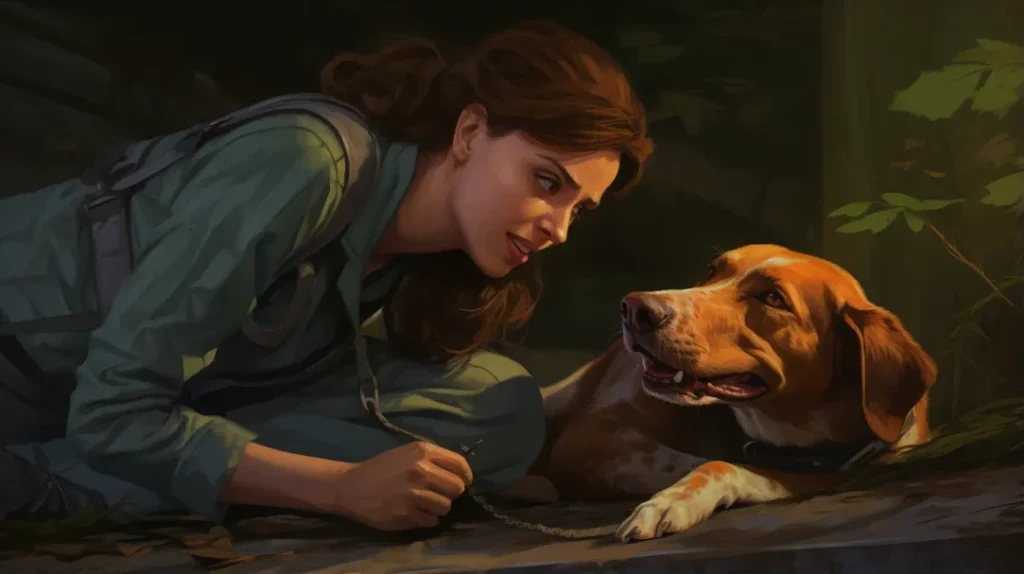Did you know that an estimated 150,000 dogs are bitten by snakes yearly? When your beloved furry friend encounters a venomous serpent, every second counts. In this article, we will guide you about what to do if a snake bites your dog? And the immediate actions to take when a snake bites your dog, ensuring their safety and increasing their chances of survival.
From recognizing the signs to contacting emergency veterinary care and providing first aid, you’ll be equipped with the knowledge needed to handle this terrifying situation.
Key Takeaways
- It recognizes the signs of a snake bite, such as swelling, redness, pain, drooling, difficulty breathing, and weakness or collapse.
- Take immediate actions, including assessing the bite, restricting the dog’s movement, applying pressure if bleeding, and contacting emergency veterinary care.
- Safely restraining and transporting your dog using appropriate restraints, leash training, proper restraint techniques, and a secure crate or carrier.
- Handling injured dogs by assessing the injuries, seeking veterinary care, following first aid measures, and considering further examination and treatment.
What To Do If A Snake Bites Your Dog
When a snake bites a dog, acting fast and appropriately is critical. Here’s a step-by-step guide on what to do:
- Keep Calm: Maintaining your composure is essential to avoid panicking your dog. Your dog will sense your anxiety, which may increase their heart rate and speed up venom spreading if the snake is venomous.
- Identify the Snake: Try to get a glimpse or remember the snake’s appearance if possible. Do not attempt to catch or kill the snake, as this will put you at risk. Snake identification can significantly help your vet with treatment.
- Move your Dog Away: Move your dog away from the snake if it’s still nearby to prevent further bites.
- Immobilize and Keep Your Dog Calm: Keep your dog as still and calm as possible. Movement can hasten the spread of venom through the body.
- Do Not Attempt Any First Aid That Can Worsen the Condition: Avoid trying to suck out the venom or applying a tourniquet. These methods are often ineffective and can cause more harm than good.
- Head to the Vet Immediately: Save time. Every moment counts in such emergencies. Call if possible to let them know you’re dealing with a potential snake bite.
- Monitor Your Dog: On the way to the vet, monitor your dog’s symptoms. Rapid symptom progression can mean a highly venomous snake bites your dog.
Recognizing the Signs of a Snake Bite
Recognizing the signs quickly is crucial for your dog’s well-being when it comes to snake bites. Look out for puncture wounds, indicating your dog has been bitten. Remember, it is not necessary to identify the snake, so don’t waste time trying.
Other clinical signs include swelling, redness, and pain around the bite area. Dilated pupils or respiratory distress are severe warning signs that require immediate veterinary attention. Keep an eye out for bleeding, both externally and internally, as well as changes in behavior like lethargy or weakness.
It’s important to note that symptoms can vary depending on the snake species. Some venomous snakes may cause blood pressure changes and bloody urine, while others can lead to paralysis and breathing difficulties.
Act swiftly by contacting your veterinarian right away. They will guide you on immediate actions, such as applying ice packs to reduce swelling and keeping your dog calm to prevent venom spread. Remember, time is of the essence in an emergency like this. Stay vigilant and seek prompt veterinary care to protect your beloved pet.
Indicators of a Venomous Snake Bite
When identifying a venomous snake bite on your dog, there are key indicators to look out for. Puncture wounds indicate your dog has been bitten, so always check for them. Swelling, redness, and pain around the bite area are common symptoms. Dilated pupils and respiratory distress are severe warning signs that require immediate veterinary attention.
External and internal bleeding, as well as changes in behavior like lethargy or weakness, should not be ignored. Remember, it is not necessary to identify the snake species, so focus on recognizing and addressing the symptoms promptly. Being observant and taking swift action can help ensure your dog receives the necessary medical care in an emergency.
Signs and Symptoms of a Snake Bite in Dogs
When a snake bites your dog, acting quickly and seeking immediate veterinary care is crucial. Knowing the signs and symptoms of a snake bite can help you take the necessary actions.
Some common signs and symptoms of a snake bite in dogs include:
1. Puncture wounds: Look for visible bite marks or puncture wounds on your dog’s body, particularly around the face and limbs.
2. Swelling and pain: A snake bite can cause rapid swelling and severe pain in the affected area.
3. Dilated pupils: You may notice your dog’s pupils becoming dilated, indicating the presence of venom in their system.
4. Lethargy and weakness: Your dog may become weak and lethargic, showing signs of distress.
5. Respiratory distress: A snake bite can lead to difficulty breathing, including heavy panting or shallow breathing.
If you suspect a snake has bitten your dog, do not attempt to handle or catch the snake. Instead, keep your dog as calm as possible and contact your veterinarian immediately. Prompt medical attention is crucial in snake bite cases to minimize the potential complications and provide the appropriate treatment.
Keeping Calm and Assessing the Situation

Stay calm and quickly evaluate the situation after your canine gets bitten by a serpent. Remember, your dog’s well-being depends on your ability to stay composed and take immediate action. Here are some essential first-aid measures you can take:
- Assess the bite: Carefully examine the edge area for any signs of swelling, bleeding, or puncture wounds. Take note of the snake’s appearance, as this information can be helpful for medical professionals.
- Please keep your dog still: Restrict their movement to prevent venom from spreading rapidly throughout their body. Carry smaller dogs if necessary, and use a leash or makeshift stretcher for larger breeds.
- Apply pressure: If bleeding, gently apply pressure with a clean cloth or bandage to help control it.
Contacting Emergency Veterinary Care
When a serpent bites your canine, it’s essential to contact veterinary care as soon as possible. Time is of the essence in these situations, and immediate medical attention can make all the difference in saving your dog’s life. You should have emergency veterinary care numbers readily available to ensure a quick response.
Safely Restraining and Transporting Your Dog

To ensure the safety of your furry friend, it is crucial to understand proper dog restraints, safe transportation methods, and how to handle injured dogs.
Using appropriate restraints, such as harnesses or crates, can prevent accidents and injuries while traveling with your dog.
Additionally, learning how to transport a dog in a vehicle safely and knowing what to do in case of an injury will help you provide the best care for your canine companion.
Proper Dog Restraints
Using the proper dog restraint is crucial when dealing with a snake bite. Here are three essential things to consider:
- Dog Muzzles: Keep a muzzle handy in case of emergencies. An adequately fitted muzzle can prevent your dog from biting you or anyone else while you administer first aid.
- Leash Training: Teach your dog to walk calmly on a leash so that you have better control during an emergency. This will help prevent them from running away or getting into further danger after a snake bite.
- Proper Restraint Techniques: Learn how to properly restrain your dog using techniques like the ‘Hug Method’ or ‘Towel Wrap.’ These methods ensure your and your dog’s safety while allowing you to examine and treat the snake bite.
By following these guidelines, you can effectively handle the situation and provide immediate care for your injured pet.
Now, let’s move on to safe transportation methods for your dog.
Safe Transportation Methods
If you plan to transport your dog, you must ensure their safety using a secure crate or carrier.
Dog carriers are designed to keep your furry friend safe and secure during car rides. They provide a cozy and confined space that prevents your dog from roaming around the car and potentially causing accidents.
When choosing a dog carrier, ensure it is the appropriate size for your pet and has proper ventilation. Additionally, always secure the carrier in the car using seat belts or other restraints to prevent it from sliding or tipping over during sudden stops or turns.
Handling Injured Dogs
When a dog is injured, it’s crucial to remain calm and assess the situation carefully. Here are three essential steps to follow when handling an injured dog:
- Ensure your safety: Protect yourself from any potential harm before approaching the wounded dog. Wear gloves if available and use caution to avoid getting bitten or scratched.
- Assess the injuries: Carefully examine the dog for any visible wounds or signs of trauma. Look for bleeding, broken bones, or difficulty breathing. Take note of the severity of injuries, as this will help determine the appropriate course of action.
- Seek immediate veterinary care: In case of serious injuries or unsure how to proceed, contact a veterinarian immediately for guidance. They can advise on first aid measures and may recommend bringing the dog in for further examination and treatment.
Identifying the Snake and Seeking Antivenom
When a snake bites your dog, it’s crucial to identify the snake species to determine the appropriate antivenom quickly. You can do this by examining the bite marks and noting any distinctive features or patterns on the snake.
Seeking antivenom immediately is paramount as it can neutralize the venom and prevent further complications. Remember, time is of the essence when treating snake bites, so prompt action is essential for your dog’s well-being.
Snake Identification Methods
Take a moment to learn some snake identification methods to help you better protect your furry friend. When it comes to snakebite treatment and prevention, knowing the type of snake that bit your dog can be crucial.
Here are three practical ways to identify snakes:
- Color and pattern: Observe the coloration and patterns on the snake’s scales. This can provide valuable clues about its species.
- Head shape: Pay attention to the shape of the snake’s head. Venomous snakes typically have triangular-shaped heads, while non-venomous ones have more rounded heads.
- Eye shape: Look closely at the snake’s eyes. Venomous snakes often have vertical pupils, similar to cat eyes, while non-venomous snakes generally have round pupils.
Importance of Seeking Antivenom
You must seek antivenom promptly if you suspect a venomous snake has bitten your furry friend. Antivenom is the most effective treatment for snake bites in dogs, and time is of the essence when administering it.
Antivenom works by neutralizing the toxins in the snake’s venom, preventing further damage and giving your dog the best chance at recovery. However, it’s important to note that antivenom availability can vary depending on your location and the specific type of snake involved.
You must contact a veterinarian immediately if you suspect a snake bite. They can assess the situation, determine whether antivenom is necessary, and provide guidance on where to find it.
Time-Sensitive Nature of Treatment
Acting promptly is crucial in seeking antivenom for a venomous snake bite. Time is of the essence when dealing with such emergencies, and every second counts. Here are three reasons why immediate action is necessary:
- First Aid Techniques: Acting quickly allows you to administer basic first aid techniques that can help minimize the effects of the snake bite. Applying pressure to the wound, immobilizing the affected limb, and keeping the victim calm are all essential steps in preventing further complications.
- Snake Bite Complications: Without prompt treatment, snake bites can lead to severe complications such as tissue damage, infection, or even systemic reactions that affect vital organs. Seeking medical attention immediately increases the chances of a successful recovery and reduces potential long-term consequences.
- Timely Antivenom Administration: The effectiveness of antivenom diminishes over time after a snake bite occurs. By acting promptly and obtaining antivenom as soon as possible, you increase its effectiveness and improve the likelihood of a positive outcome.
Understanding these time-sensitive aspects of snakebite treatment allows you to take swift action when needed and ensure better outcomes for victims in need.
Now, let’s discuss ways to prevent snake bites in the future.
Preventing Snake Bites in the Future

To prevent future snake bites, ensure you keep your yard clear of tall grass and debris. Snakes are attracted to areas with hiding spots and potential prey, so maintaining a clean and well-maintained yard can discourage them from entering. Here are some additional tips for snake-proofing your backyard:
| Column 1 | Column 2 | Column 3 |
|---|---|---|
| Remove clutter | Seal gaps and cracks | Install snake fencing |
| Keep vegetation trimmed | Store firewood properly | Clear away food sources |
| Avoid attracting rodents | Use motion-activated lights | Regularly inspect yard |
Remember that prevention is critical when protecting your pets from snake bites. In addition to keeping your yard safe, consider training your dogs or cats to avoid snakes through professional obedience classes or scent training. You should also be vigilant during walks or hikes in natural areas where snakes may be present. Taking these precautions can significantly reduce the risk of snake bites for yourself and your beloved pets.
Frequently Asked Questions
How Long Does It Take for Snake Venom to Take Effect on a Dog?
When a snake bites your dog, the venom can take effect within minutes. It is crucial to seek immediate treatment for your dog’s snake bite, as time is of the essence in preventing further complications.
Can Dogs Die From Snake Bites?
Snake bites can be fatal for dogs. In fact, according to a study, 20% of dogs bitten by venomous snakes die within hours if not treated promptly. Symptoms include swelling, pain, and difficulty breathing.
Are All Snake Bites Poisonous to Dogs?
Not all snake bites are poisonous to dogs. Different types of venomous snakes have varying effects on dogs. Keep your property free from tall grass and debris to prevent snake bites.
How Much Does Antivenom for Snake Bites Cost?
Antivenom availability and where to find it is crucial when a snake bites your dog. The cost of antivenom varies, but it can range from $500 to $2000 per vial, depending on the type of snake and location.
Can I Use a Tourniquet to Stop the Venom From Spreading After a Snake Bite?
No, you should not use a tourniquet to stop the venom from spreading after a snake bite. It can worsen tissue damage and increase the risk of infection. Focus on preventing shock and seek immediate veterinary care.
Conclusion
In conclusion, remember that swift and calm actions are crucial in the face of a snake bite emergency. Your immediate response can make all the difference for your beloved canine companion.
By recognizing the signs, contacting emergency veterinary care, safely restraining and transporting your dog, administering first aid measures, identifying the snake, and taking preventive measures for the future, you are equipped to handle this potentially life-threatening situation.
So be prepared and stay vigilant because when it comes to snake bites, time is of the essence – every second counts.
Quick Paw Note: While we’re passionate about providing helpful pet nutrition content, it’s essential to remember that this info isn’t a substitute for professional veterinary advice. Always consult your vet for your pup’s specific dietary needs. We strive for accuracy, but paw-lease note that we can’t guarantee the complete reliability of all content. Stay pawsome! 🐾




